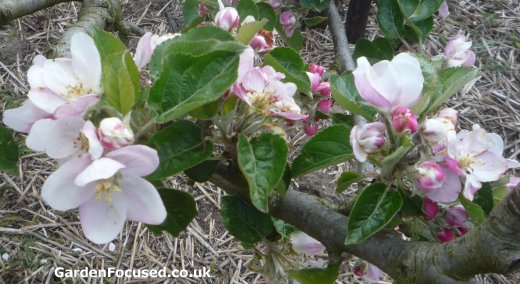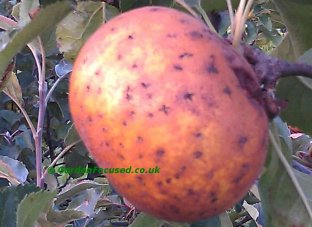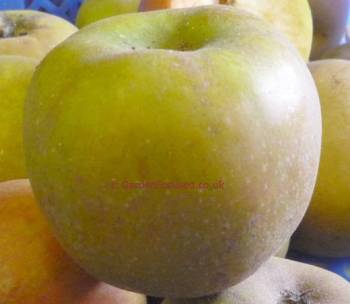PARENTAGE
The parents of Ashmead’s Kernel are in reality unknown although some suggest a relationship to the Duke of Devonshire apple tree. A more likely parent is Nonpareil as suggested in Hogg’s Fruit Manual when he writes “….. and will succeed in situations unfavourable to the Nonpareil, to which its leaves and shoots bear such a similarity as to justify Mr. Lindley in believing it to be a seedling from that variety.”
APPEARANCE, TASTE AND CHARACTERISTICS OF ASHMEAD’S KERNEL
The appearance of the apple is best described as dull although some develop a red tinge which improves things considerably. The skin definitely has lots of russet texture. As far as size goes Ashmead’s Kernel apples are slightly smaller than average and the shape can be slightly irregular.
As far as taste goes, this is definitely one of the best apples of all time. A slightly acidic pear taste and aroma is one way to describe it and in blind tastings this variety more frequently than not comes out tops for taste.
The flesh is crisp and juicy – if the apples were larger they would probably be used for cider making and even juicing but the smallish size makes that problematic.
This is firstly an eating apple which tastes best straight from the tree when fully ripe. They will keep for six weeks or so as long as they are in perfect condition.
Look after this variety of apple trees well and it will reward you with a fair crop of superb tasting apples but it is not a tree which should be left untended for years on end. Every three or four years it will fail to crop well for no apparent reason.

In the good years Ashmead’s Kernel will yield a reasonable crop of apples and the blossom is particularly attractive (see picture below). A small percentage of the apples will suffer from bitter pit although the reason is not clear. Normally bitter pit is associated with uneven uptake of water and / or a chemical deficiency but this variety always seems to suffer to a small degree whatever the growing conditions. Resistance to other diseases and pests is good.

![]()
Blossom of Ashmead’s Kernel
This is not a particularly strong growing variety so we would always go for an MMM106 rootstock which will give the tree some vigour. It is self-sterile (in pollination group 4) and therefore needs a pollination partner (it is also be triploid).
With all its disadvantages though, the taste and aroma of Ashmead’s Kernel is a delight and make this a truly worthwhile variety to grow.
BUYING ASHMEAD’S KERNEL APPLE TREE
We’ve rarely seen one for sale in a mainstream garden centre nor any of the diy stores. They are available from specialist nurseries if you search hard. The easiest way to obtain your very own Ashmead’s Kernel is to buy online, there are four or five well known suppliers to choose from.
It is clear that the prices of quality trees varies enormously depending on your chosen supplier. For example Keepers Nursery look good at first glance. However an advertised price of only £16.50 turns into an exceptionally high £31.00 when you add in their £14.50 delivery charge!
VAT, delivery charges and other incidentals all need to be taken into account! We would also advise that buying a bare-rooted Ashmead’s Kernel is roughly £10 cheaper than the equivalent potted tree. There is no difference in quality so always try to buy the bare-rooted tree.
Our recommendation for rootstock would be to buy it on either M26 or MM106 for the average sized garden.
ASHMEAD’S KERNEL PESTS AND DISEASES
Ashmead’s Kernel has good disease resistance especially to scab and mildew, two of the most common apple tree problems. This makes it a good choice for wetter areas of the UK.
The apples are however, prone to bitter pit and the symptoms are small brown / black marks on the surface of the skin. Cutting the apple in half reveals that under the brown surface marks, the flesh of the apple is also stained. The picture shown below is rather extreme but it does illustrate the effects very clearly.

The apples quickly become bitter and inedible. This condition is caused by an irregular supply of water at the roots. Mulching under the full canopy area and just beyond greatly helps. For a full description of bitter pit, click here.
For a full description of common apple pests and diseases click here.
ALTERNATIVES TO ASHMEAD’S KERNEL
When looking for an alternative to Ashmead’s Kernel you need to take into account the excellent flavour of this variety. You will be looking for a mid to late season variety which produces good looking apples and preferably a russet type. Disease resistance for any alternative needs to be good.
Two varieties which fit the replacement criteria are:
- EGREMONT RUSSET – the most popular of all the russet apples in the UK. A nutty flavour which is very tasty but not like modern apples. Similar good pest and disease resistance. Egremont Russet has a shorter storage life, a month at the maximum but has the advantage of being partially self-fertile.
- CLAYGATE PEARMAIN – Only parts of the skin are russet, this is an excellent choice. A late variety which will grow well in cooler parts of the UK. It is a triploid variety. Good disease resistance with no bitter pit problems. Full of juice and lots of flavour. Keeps for a month or so.
ASHMEAD’S KERNEL FLOWERING AND HARVEST TIMES:
The average flowering time (optimum time for pollination) and date when fruits are ripe in the UK for the Ashmead’s Kernel apple tree are set out below. If you have set your home town we can give you a more accurate estimate, if you have not set your home town (do it now by clicking here) the dates below will be the average for the UK.
Your town has not been set, the average main flowering time for Ashmeads Kernel
in the UK is the second / third weeks of May. Fruit will be ready for harvesting in the second week of October.
Click here if you want to set the dates to your home town.
Flowering and fruit picking dates vary according to the weather in any particular growing season so the above dates may well change slightly from one year to the next. The flowering date above is when the apple tree produces the maximum number of blossoms, it will also produce blossom, although less, a week or two either side of the date given.
SUMMARY CHARACTERISTICS OF ASHMEAD’S KERNEL
USE: Eating apple
SKIN COLOUR / TEXTURE: Russet, dull green colour with a few orange streaks
FLESH COLOUR: White
TASTE AND TEXTURE: One of the best tasting apples of all time, pear flavour with slight acidic background, crisp.
FRUIT SIZE: Slightly below average
STORING QUALITIES: Two months
PRODUCES FRUIT: Mid October (see here for more details)
SUITABILITY FOR CORDON / ESPALIER GROWTH: Yes
TREE SIZE: Average size depending on rootstock used, takes time to grow to maturity
REGULARITY OF CROPPING: Can miss a year occasionally
POLLINATION: Group 4, self sterile and needs a suitable pollination partner. This variety is also a triploid.
AWARDS: RHS AGM in 1993 and reconfirmed in 2013
SPECIAL FEATURES: Superb tasting apples, truly delicious
ASHMEAD’S KERNEL POLLINATION
We list below varieties which are suitable pollination partners for Ashmead’s Kernel which is in pollination group 4 and self-sterile (also a triploid).
- Arthur Turner – pollination group 3, self-sterile, cooker
- Bountiful – pollination group 3, self-sterile, cooker
- Braeburn – pollination group 4, self-fertile, eater
- Charles Ross – pollination group 3, partially self-fertile, cooker and eater
- Court of Wick – pollination group 3, self-sterile, eater and cooker
- Discovery – pollination group 3, self-sterile, eating and cider
- Dumelow’s Seedling – pollination group 4, self-sterile, cooker
- Ellison’s Orange – pollination group 4, partially self-fertile, eater
- Emneth Early – pollination group 3, partially self-fertile, cooker
- Epicure – pollination group 3, self-fertile, eater
- Falstaff – pollination group 3, self-fertile, eater
- Fiesta – pollination group 3, partially self-fertile, eater
- Gala – pollination group 4, partially self-fertile, eater
- Golden Delicious – pollination group 4, partially self-fertile, eater and cooker
- Granny Smith – pollination group 3, self-fertile, eater and cooker
- Grenadier – pollination group 3, partially self-fertile, cooker
- Honeycrisp – pollination group 4, self-sterile, eater
- Howgate Wonder – pollination group 3, partially self-fertile, cooker and eater
- James Grieve – pollination group 3, partially self-fertile, cooker and eater
- Katy – pollination group 3, self-sterile, both
- Kidds Orange Red – pollination group 3, self-sterile, eater
- King of The Pippins – pollination group 4, partially self-fertile, eater and cooker
- Lanes Prince Albert – pollination group 4, self-sterile, cooking
- Laxtons Fortune – pollination group 3, partially self-fertile, eater
- Laxtons Superb – pollination group 4, partially self-fertile, eater
- Lord Derby – pollination group 4, self-sterile, cooker
- Merton Beauty – pollination group 5, self-sterile, eater
- Newton Wonder – pollination group 4, partially self-fertile, cooker
- Peasgoods Nonsuch – pollination group 3, partially self-fertile, cooker
- Rajka – pollination group 4, self-sterile, eater
- Red Falstaff – pollination group 3, partially self-fertile, eater
- Scrumptious – pollination group 3, self-fertile, eater
- Sops in Wine – pollination group 3, self-sterile, juicer
- Spartan – pollination group 3, self-fertile, eater
- Sunset – pollination group 3, self-fertile, eater
- Tydemans Late Orange – pollination group 4, self-sterile, eater
- Waltz – pollination group 3, self-sterile, eater
- Winston – pollination group 4, self-fertile, eater
- Worcester Pearmain – pollination group 3, partially self-fertile, eater
The full list of apple tree varieties which we have reviewed is listed below. Select any one of them and then click the “More Information” button to be taken to the in depth review:

Rootstocks and Size
Guide to Planting
Care Plan
Pruning Apple Trees
Harvest and Storage
Pests and Disease
Pollination Groups
ASHMEADS KERNEL APPLE TREE
Ashmead’s Kernel is one of the oldest apple varieties in the UK dating back to around 1700. The fact that it has survived over 300 years is down to its flavour. Unique and top quality is the only way to describe it
It has to be said that this variety does have its own particular problems and the most obvious one it that it looks boring! The dull slightly brown and well-russeted skin has none of the appeal of a modern red flushed apple. It is however well worth growing this variety, it will certainly win admiration from fellow gardeners.